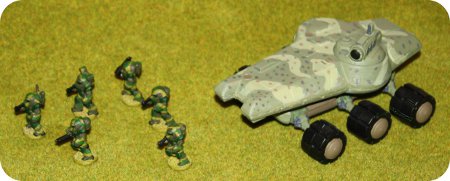Ultra Tech
Hard SF is a term used to describe science fiction with a plausible and self-consistent use of science and technology. It doesn't necessarily mean near future (though it often can). Cyberpunk is well suited to Hard SF, though not all Cyberpunk is Hard SF.

Ultra Tech assumes a faster progression of computer and bio technology than is presented in scifi, with mind uploading, nanotech and other staples of modern SF being available relatively early.
If your only source of science fiction is Hollywood, then there is a whole branch of SF which you are probably not familiar with known as Hard SF. Authors such as Charles Stross, Alistair Reynolds, Stephen Baxter and Greg Bear have portrayed a very different view of the future.
The science in this fiction tends to be based on what is already known about the universe, only adding fantastic science in when it is absolutely required. Often, only a single fantastic element will be added, and the consequences of that technology will be explored to death. Cyberpunk is one sub-genre that often fits into this style - a setting which explores the consequences of human-machine interactions and the ubiquity of computer networks.
Such fiction isn't limited just to the near future however. The war between the humans and the Xeelee in Stephen Baxter's future history resulted in the use of neutron stars and weapons and the destruction of whole galaxies.
Future technologies are broken down by technology level, starting at TL 8 for the modern day and going up to TL 15. Technology levels beyond this are difficult to define.
Future History
Tomorrow (TL 8-9)
As TL 8 draws to the close by 2020, computer technology continues to improve at a fantastic rate. Mobile devices become more integrated with everyday life, as every person becomes their own network of connected devices, from their phone to their car and central heating system.
As a new generation grows up used to sharing their inner secrets on social networks, so privacy becomes harder to find. Most cultures allow everybody to be tracked (for their own safety), and opting out becomes less of an option. Automatic face recognition by CCTV cameras, cross linked to tracking of mobile phones and in-car SatNav's mikes hiding almost impossible.
Turing Personalities, which are expert machines able to mimic humans in a narrow domain, become practical in real world situations, such as on help desks and reception tasks.

As civilisation moves into TL 9, so the medical revolutions of the past 20 years continues to expand. Genetic engineering of humans becomes possible, combating disease before a person is even born. Only legal and moral obstacles prevents human cloning, but growing spare organs in the lab is common place. Dying from disease becomes something that happens rarely, though eventual mental breakdown becomes the final reason for death for most people.
Wireless power and huge improvements in energy storage greatly improve the usefulness of small devices. On a bigger scale, there is a greater move to renewable energy sources, with a focus on distributed systems, especially as solar power becomes cheaper and more effective.
Cybernetic enhancements, already possible by the end of TL 8, become more effective and exotic, as well as more socially acceptable. Nano-tech bugs that monitor a body for signs of ill-health, coupled with other pro-active health implants are available for those able to pay (both injecting drugs, and nullifying their effects (especially those of alcohol) are among the more common options).
Space travel becomes commercialised, fuelled by the needs of tourists. Improvements in ion drives and experimentation with new plasma rockets make manned exploration of the inner solar system possible.
Beyond the Earth (TL 10-11)
By the end of the 21st century, space exploration isn't just a few highly trained astronauts in a small tin can. Permanent hotels in orbit, and even on the moon, are practical.
Synthetic androids capable of behaving like a human become possible, though most people can recognise them as such through conversation. AI automation begins to take over many tasks normally reserved for humans, and most vehicle transportation has become fully automated by early TL 10. By TL 10 direct interfaces between mind and machine are becoming possible, and by TL 11 the distinction begins to become blurred, as memories (rather than simple instructions) can be copied from one to the other as people view Mind as Software
New composite materials become possible, by building up objects atom by atom. Nano-tech replication also allows rapid construction of large scale structures from software templates. Both food and fuel can be grown in the factories, solving both the food crisis and energy crisis at the same time. Fusion reactors finally become feasible.
Permanent colonies can be found on the Moon and Mars, with manned exploration of the outer planets beginning as well. The mining of asteroids is practical for certain rare materials, but very practical for helping boot strap a space based culture.
This is the level of technology available in settings such as Ghost in the Shell or Transhuman Space.
Lords of Matter (TL 12-13)
It becomes possible to manipulate the very structure of matter and energy, allowing whole new types of elements to be constructed with exotic properties. Anti-matter drives open up the solar system to regular travel, and makes the exploration of the nearest stars feasible (though still difficult).
The economy has changed radically by this point, with information and energy being the most important commodities. Replication and nano-factories can build most physical objects, and personal identities tend to be split across multiple physical shells - whether organic or otherwise. Many disappear into virtual worlds, though the majority still prefer the reality of physical space.
Lords of Time and Space (TL 14-15)
The manipulation of wormholes allows the creation of two way transmission of information instantly between two points. As the technology improves, so the wormholes become larger, permitting the travel of physical objects from one place to another. A network of links begins to spread not only across the solar system, but between solar systems.
The number of physical people living in space exceeds the number living on planets, and the human population continues to rapidly expand. Raw material and energy can be fashioned into anything required given time and the right machines.
